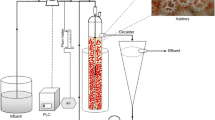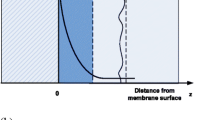Abstract
Aeration strategy played an important role in reactor performance. In this study, when superficial upflow air velocity (SAV) decreased from 0.16 to 0.08 cm s−1, low dissolved oxygen concentration (DO) of 2.0 mg L−1 occurred in reactor. The required depth for anoxic microenvironment in biofilm decreased from 902.3 to 525.9 μm, which enhanced the growth of denitrifying bacteria and total nitrogen (TN) removal efficiency. However, decreasing aeration intensity resulted in insufficient hydraulic shear stress, which led to weak biofilm matrix structure. Mass biofilm detachment and reactor deterioration then occurred after 87 days of operation. An end gas recirculation aeration strategy was proposed to separately manipulate DO and aeration intensity. Low DO and high aeration intensity were simultaneously achieved, which enhanced the metabolism of denitrifying bacteria (such as Flavobacterium sp., Pseudorhodobacter sp., and Dok59 sp.) and EPS-producing bacteria (such as Zoogloea sp. and Rhodobacter sp.). Consequently, high TN removal performance (82.1 ± 2.7%) and stable biofilm structure were achieved.






Similar content being viewed by others
References
Adav SS, Lee DJ, Show KY, Tay JH (2008) Aerobic granular sludge: recent advances. Biotechnol Adv 26:411–423
Adav SS, Lee DJ, Lai JY (2010) Potential cause of aerobic granular sludge breakdown at high organic loading rates. Appl Microbiol Biotechnol 85:1601–1610
Aline L, Stéphane D, Philippe M, Fabrice B, Stéphane P, Michel F, Eric O (2017) Impact of shear stress and impeller design on the production of biogas in anaerobic digesters. Bioresour Technol 245:1139–1147
APHA., AWWA., WEF (2012) Standard methods for the examination of water and wastewater, 22nd edn. American Public Health Association, American Water Works Association, and Water Environment Federation, Washington
Bereschenko LA, Stams AJM, Euverink GJW, van Loosdrecht MCM (2010) Biofilm formation on reverse osmosis membranes is initiated and dominated by Sphingomonas spp. Appl Environ Microbiol 76:2623–2632
Bian D, Zhou D, Huo M, Ren Q, Tian X, Wan L, Zhu S, Ai S (2015) Improving oxygen dissolution and distribution in a bioreactor with enhanced simultaneous cod and nitrogen removal by simply introducing micro-pressure and swirl. Appl Microbiol Biotechnol 99:8741–8749
Cao YF, Zhang CS, Rong HW, Zheng GL, Zhao LM (2017) The effect of dissolved oxygen concentration (DO) on oxygen diffusion and bacterial community structure in moving bed sequencing batch reactor (MBSBR). Water Res 108:86–94
Cortés-Lorenzo C, Rodríguez-Díaz M, López-Lopez C, Sánchez-Peinado M, Rodelas B, González-López J (2012) Effect of salinity on enzymatic activities in a submerged fixed bed biofilm reactor for municipal sewage treatment. Bioresour Technol 121:312–319
Etchebehere C, Cabezas A, Dabert P, Muxi L (2003) Evolution of the bacterial community during granules formation in denitrifying reactors followed by molecular, culture-independent techniques. Water Sci Technol 48:75–79
Gonzalez-Gil G, Holliger C (2014) Aerobic granules: microbial landscape and architecture, stages, and practical implications. Appl Environ Microbiol 80:3433–3441
Guo Q, Shi ZJ, Yang CC, Huang M, Xu JL, Xu YQ, Ni WM, Jin RC (2017) Individual and combined inhibition of phenol and thiocyanate on microbial activity of partial nitritation. Environ Sci Pollut Res 24:14207–14217
Jarvis P, Jefferson B, Gregory J, Parsons SA (2005) A review of floc strength and breakage. Water Res 39:3121–3137
Kim S, Yu K, Yoon B, Lim Y (2012) A numerical study on hydraulic characteristics in the ice harbor-type fishway. KSCE J Civ Eng 16:265–272
Kornaros M, Dokianakis SN, Lyberatos G (2010) Partial nitrification/ denitrification can be attributed to periodic anoxic disturbances. Environ Sci Technol 44:7245–7253
Liu Y, Li WW, Sheng GP, Liu ZF, Zeng RJ, Liu JX, Yu HQ, Lee DJ (2010) Microscale hydrodynamic analysis of aerobic granules in the mass transfer process. Environ Sci Technol 44:7555–7560
Lochmatter S, Gonzalez-Gil G, Holliger C (2013) Optimized aeration strategies for nitrogen and phosphorus removal with aerobic granular sludge. Water Res 47:6187–6197
Nielsen PH, Mielczarek AT, Kragelund C, Nielsen JL, Saunders AM, Kong Y, Hansen AA, Vollertsen J (2010) A conceptual ecosystem model of microbial communities in enhanced biological phosphorus removal plants. Water Res 44:5070–5088
Paul E, Ochoa JC, Pechaud Y, Liu Y, Line A (2012) Effect of shear stress and growth conditions on detachment and physical properties of biofilms. Water Res 46:5499–5508
Rahimi Y, Torabian A, Mehrdadi N, Shahmoradi B (2011) Simultaneous nitrification-denitrification and phosphorus removal in a fixed bed sequencing batch reactor (FBSBR). J Hazard Mater 185:852–857
Rubio-Rincon FJ, Welles L, Lopez-Vazquez CM, Nierychlo M, Abbas B, Geleijnse M, Nielsen PH, van Loosdrecht MCM, Brdjanovic D (2017) Long-term effects of sulphide on the enhanced biological removal of phosphorus: the symbiotic role of Thiothrix caldifontis. Water Res 116:53–64
Satoh H, Nakamura Y, Ono H, Okabe S (2003) Effect of oxygen concentration on nitrification and denitrification in single activated sludge flocs. Biotechnol Bioeng 83:604–607
Seviour T, Yuan ZG, van Loosdrecht MCM, Lin YM (2012) Aerobic sludge granulation: a tale of two polysaccharides? Water Res 46:4803–4813
Szabó E, Liébana R, Hermansson M, Modin O, Persson F, Wilén BM (2017) Comparison of the bacterial community composition in the granular and the suspended phase of sequencing batch reactors. AMB Express 7:168–180
Tan C, Ma F, Li A, Qiu S, Li JZ (2013) Evaluating the effect of dissolved oxygen on simultaneous nitrification and denitrification in polyurethane foam contact oxidation reactors. Water Environ Res 85:195–202
Tang B, Yu CF, Bin LY, Zhao YL, Feng XF, Huang SS, Fu FL, Ding JW, Chen CQ, Li P, Chen QY (2016) Essential factors of an integrated moving bed biofilm reactor-membrane bioreactor: adhesion characteristics and microbial community of the biofilm. Bioresour Technol 211:574–583
Tang B, Song HL, Bin LY, Huang SS, Zhang WX, Fu FL, Zhao YL, Chen QY (2017) Determination of the profile of DO and its mass transferring coefficient in a biofilm reactor packed with semi-suspended bio-carriers. Bioresour Technol 241:54–62
Tang CC, Tian Y, He ZW, Zuo W, Zhang J (2018) Performance and mechanism of a novel algal-bacterial symbiosis system based on sequencing batch suspended biofilm reactor treating domestic wastewater. Bioresour Technol 265:422–431
Vacková L, Srb M, Stloukal R, Wanner J (2011) Comparison of denitrification at low temperature using encapsulated Paracoccus denitrificans, Pseudomonas fluorescens and mixed culture. Bioresour Technol 102:4661–4666
Wasche S, Horn H, Hempel DC (2002) Influence of growth conditions on biofilm development and mass transfer at the bulk/biofilm interface. Water Res 36:4775–4784
Winkler MK, Kleerebezem R, Khunjar WO, de Bruin B, van Loosdrecht MC (2012) Evaluating the solid retention time of bacteria in flocculent and granular sludge. Water Res 46:4973–4980
Wu LY, Tang B, Bin LY, Chen GP, Huang SS, Li P, Fu FL (2018) Heterogeneity of the diverse aerobic sludge granules self-cultivated in a membrane bioreactor with enhanced internal circulation. Bioresour Technol 263:297–305
Yan L, Liu Y, Wen Y, Ren Y, Hao CX, Zhang Y (2015) Role and significance of extracellular polymeric substances from granular sludge for simultaneous removal of organic matter and ammonia nitrogen. Bioresour Technol 179:460–466
Yan L, Liu S, Liu QP, Zhang MY, Liu Y, Wen Y, Chen ZL, Zhang Y, Yang QQ (2019) Improved performance of simultaneous nitrification and denitrification via nitrite in an oxygen-limited SBR by alternating the DO. Bioresour Technol 275:153–162
Zhou JH, Zhao H, Hu M, Yu HT, Xu XY, Vidonishc J, Alvarez PJJ, Zhu L (2015) Granular activated carbon as the nucleating agent for aerobic sludge granulation: effect of GAC size on velocity field differences (GAC versus flocs) and aggregation behavior. Bioresour Technol 198:358–363
Zhou JH, Yu HT, Zhao H, Alvarez PJJ, Xu XY, Zhu L (2016) Optimizing granules size distribution for aerobic granular sludge stability: effect of a novel funnel-shaped internals on hydraulic shear stress. Bioresour Technol 216:562–570
Funding
This study was supported by National Natural Science Foundation of China [grant numbers 51708499, 21576241, and 21776262] and Hangzhou Agricultural and Social Development Research Program [20180533B03].
Author information
Authors and Affiliations
Corresponding author
Additional information
Responsible editor: Bingcai Pan
Publisher’s note
Springer Nature remains neutral with regard to jurisdictional claims in published maps and institutional affiliations.
Electronic supplementary material
ESM 1
(DOC 3333 kb)
Rights and permissions
About this article
Cite this article
Zhou, J.h., Yu, H.c., Ye, K.q. et al. Optimized aeration strategies for nitrogen removal efficiency: application of end gas recirculation aeration in the fixed bed biofilm reactor. Environ Sci Pollut Res 26, 28216–28227 (2019). https://doi.org/10.1007/s11356-019-06050-9
Received:
Accepted:
Published:
Issue Date:
DOI: https://doi.org/10.1007/s11356-019-06050-9




